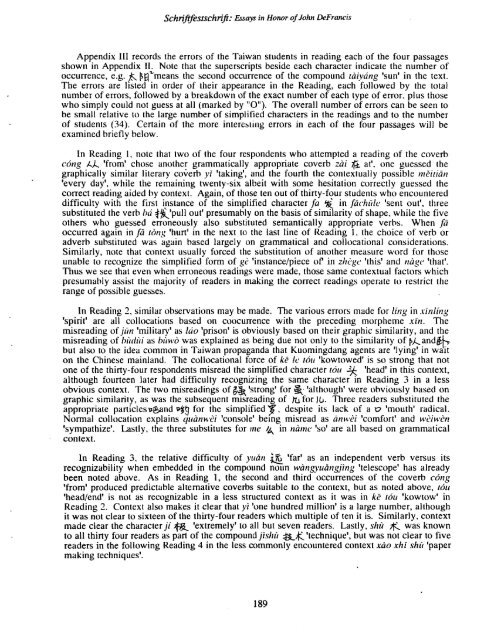Essays on Writing and Language in Honor - Sino-Platonic Papers
Essays on Writing and Language in Honor - Sino-Platonic Papers
Essays on Writing and Language in Honor - Sino-Platonic Papers
You also want an ePaper? Increase the reach of your titles
YUMPU automatically turns print PDFs into web optimized ePapers that Google loves.
Schrifrestschn'fi: &says <strong>in</strong> H<strong>on</strong>or of John DeFrancis<br />
Appendix 111 records the errors of the Taiwan students <strong>in</strong> read<strong>in</strong>g each of the four passages<br />
shown <strong>in</strong> Appendix 11. Note that the superscripts beside each character <strong>in</strong>dicate the number of<br />
occurrence, e.g. 6 bd'rneans the sec<strong>on</strong>d occurrence of the compound tai-vang 'sun' <strong>in</strong> the text.<br />
The errors are llsted <strong>in</strong> order of their appearance <strong>in</strong> the Read<strong>in</strong>g, each followed by the total<br />
number of errors, followed by a breakdown of the exact number of each type of error. plus those<br />
who simply could not guess at all (marked by "0"). The overall number of errors can be seen to<br />
be small relative to the large number of simplified characters <strong>in</strong> the read<strong>in</strong>gs <strong>and</strong> to the number<br />
of students (34). Certa<strong>in</strong> of the more <strong>in</strong>terebiir~g errors <strong>in</strong> each of the four passages will be<br />
exam<strong>in</strong>ed briefly below.<br />
In Read<strong>in</strong>g 1, note that two of the four resp<strong>on</strong>dents who attempted a read<strong>in</strong>g of the coverb<br />
corrg A).. 'from' chose another grammatically appropriate coverb zai 6 at'. <strong>on</strong>e guessed the<br />
graphically similar literary cocerb pi 'tak<strong>in</strong>g', <strong>and</strong> the fourth the c<strong>on</strong>textually possible rrreirian<br />
'every day'. while the rema<strong>in</strong><strong>in</strong>g twenty -six a1 beit with some hesitati<strong>on</strong> correctly guessed the<br />
correct read<strong>in</strong>g aided by c<strong>on</strong>text. Aga<strong>in</strong>, of those ten out of thirty-four students who encountered<br />
difficulty with the first <strong>in</strong>stance of the simplified character fa 6 <strong>in</strong> fa(-hlile 'sent out', three<br />
substituted the verb hti #%'pull out' presumably <strong>on</strong> the basis of similarity of shape, while the five<br />
others who guessed err<strong>on</strong>eously also substituted semantically appropriate verbs. When fa<br />
occurred aga<strong>in</strong> <strong>in</strong> jZ ~dng 'hurt' <strong>in</strong> the next to the last l<strong>in</strong>e of Read<strong>in</strong>g 1, the choice of verb or<br />
adverb substituted was aga<strong>in</strong> based largely <strong>on</strong> grammatical <strong>and</strong> collocati<strong>on</strong>al c<strong>on</strong>siderati<strong>on</strong>s.<br />
Similarly, note that c<strong>on</strong>text usually forced the substituti<strong>on</strong> of another measure word for those<br />
unable to recognize the simplified form of gi. '<strong>in</strong>stancelpiece of <strong>in</strong> zl12gb.~~ 'this' <strong>and</strong> r~agr 'that1.<br />
Thus we see that even when err<strong>on</strong>eous read<strong>in</strong>gs were made, those same c<strong>on</strong>textual factors which<br />
presumably assist the majority of readers <strong>in</strong> mak<strong>in</strong>g the correct read<strong>in</strong>gs operate to restrict the<br />
range of possible guesses.<br />
In Read<strong>in</strong>g 2, similar observati<strong>on</strong>s may he made. The various errors made for l<strong>in</strong>g <strong>in</strong> s<strong>in</strong>littg<br />
'spirit' are all collocati<strong>on</strong>s based <strong>on</strong> coocurrence with the preced<strong>in</strong>g morpheme xirl. The<br />
misread<strong>in</strong>g of jirn 'military' as ldo 'pris<strong>on</strong>' is obviously based <strong>on</strong> their graphic similarity, <strong>and</strong> the<br />
misread<strong>in</strong>g of hiirliii as hiiwo was expla<strong>in</strong>ed as be<strong>in</strong>g due not <strong>on</strong>ly to the similarity of p).<strong>and</strong>&b<br />
but also to the idea comm<strong>on</strong> <strong>in</strong> Taiwan propag<strong>and</strong>a that Kuom<strong>in</strong>gdang agents are 'ly<strong>in</strong>g' <strong>in</strong> wait<br />
<strong>on</strong> the Ch<strong>in</strong>ese ma<strong>in</strong>l<strong>and</strong>. The collocati<strong>on</strong>al force of ke le fdlr 'kowtowed' is so str<strong>on</strong>g that not<br />
<strong>on</strong>e of the thirty-four resp<strong>on</strong>dents misread the simplified character rori 'head' <strong>in</strong> this c<strong>on</strong>text,<br />
although fourteen later had difficulty recogniz<strong>in</strong>g the same character <strong>in</strong> Read<strong>in</strong>g 3 <strong>in</strong> a less<br />
obvious c<strong>on</strong>text. The two misread<strong>in</strong>gs of && 'str<strong>on</strong>g' for 'although' were obviously hased <strong>on</strong><br />
graphic similarity, as was the subsequent misread<strong>in</strong>g of for )b. Three readers substituted the<br />
appropriate particles~@<strong>and</strong> %g for the simplified 'P;. despite its lack of a D 'mouth' radical.<br />
Normal collocati<strong>on</strong> expla<strong>in</strong>s clrianw2i 'c<strong>on</strong>sole' be<strong>in</strong>g misread as l<strong>in</strong>~vei 'comfort' <strong>and</strong> wi.icr+n<br />
'sympathize'. Lastly, the three substitutes for me /I, <strong>in</strong> name 'so' are all hased <strong>on</strong> grammatical<br />
c<strong>on</strong>text.<br />
In Read<strong>in</strong>g 3, the relative difficulty of yrran 'far' as an <strong>in</strong>dependent verb versus its<br />
recognizability when embedded <strong>in</strong> the compound noun wangyuhrlgj<strong>in</strong>g 'telescope' has already<br />
been noted above. As <strong>in</strong> Read<strong>in</strong>g 1, the sec<strong>on</strong>d <strong>and</strong> third occurrences of the coverb cdng<br />
'from' produced predictable alternative coverbs suitable to the c<strong>on</strong>text, but as noted above, roll<br />
'headlend' is not as recognizable <strong>in</strong> a less structured c<strong>on</strong>text as it was <strong>in</strong> kt? tori 'kowtow' <strong>in</strong><br />
Read<strong>in</strong>g 2. C<strong>on</strong>text also makes it clear that yi '<strong>on</strong>e hundred milli<strong>on</strong>' is a large number, although<br />
it was not clear to sixteen of the thirty-four readers which multiple of ten it is. Similarly, c<strong>on</strong>text<br />
made clear the character ji 'extremely' to all but seven readers. Lastly, shu was known<br />
to all thirty four readers as part of the compound jishir &K'techniquef, but was not clear to five<br />
readers <strong>in</strong> the follow<strong>in</strong>g Read<strong>in</strong>g 4 <strong>in</strong> the less comm<strong>on</strong>ly encountered c<strong>on</strong>text xao xhi shir 'paper<br />
mak<strong>in</strong>g techniques'.

















